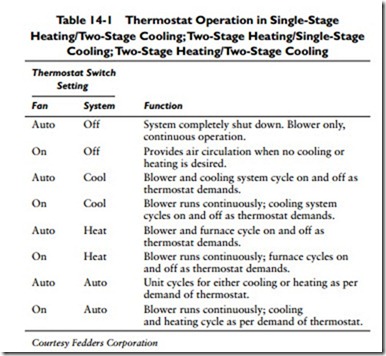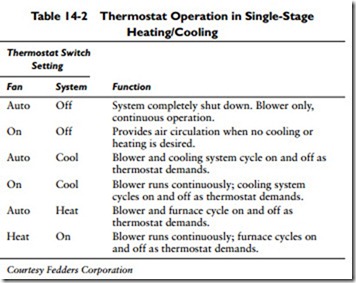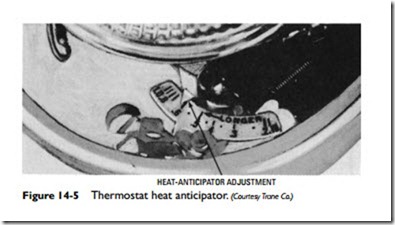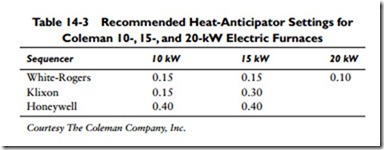Automatic Controls
The automatic controls used in an electric heating system are designed to ensure its safe and efficient operation. Detailed descriptions of these controls are found in Chapter 4, “Thermostats and Humidistats” of Volume 2. This section is primarily concerned with outlining the operating principles of the automatic controls used with an electric furnace. These controls include:
1. Room thermostat
2. Thermostat heat anticipator
3. Timing sequences
In a central heating system, the wall-mounted room thermostat is the control that governs the normal operation of the furnace. The operating principle is simple. The temperature selector on the ther- mostat is set for the desired temperature. When the temperature in the room falls below this setting, the thermostat will call for heat and cause the first heating circuit in the furnace to be turned on. There is generally a delay of about 15 seconds before the furnace blower starts. This prevents the blower from circulating cool air in the winter. After about 30 seconds, the second heating circuit is turned on. The other circuits are turned on one by one in timed sequence.
Note
Use a heat pump thermostat or a conventional thermostat containing an electric setting to operate an electric furnace.
When the temperature reaches the required level, the thermostat opens. After a short time, the first heating circuit is shut off. The others are shut off one by one in timed sequence. The blower will continue to operate until the air temperature in the furnace drops below a specified temperature.
A typical room thermostat will have a fan switch, a system switch, and a temperature selector (Figure 14-4). The temperature selector (a dial or lever device) on the thermostat is used to select the desired temperature. The actual operation of the heating system is governed by the positions of the fan and system switches. The switch positions and their functions are listed in Tables 14-1 and 14-2.
Most room thermostats contain a heat anticipator. This is a device designed to assist the thermostat in controlling closer to the desired temperature range (Figure 14-5).
When timing sequences are used (see below), the current flowing through the first time-delay sequencer (relay) must also flow through the heat anticipator. In order to obtain satisfactory opera- tion, the heat-anticipator setting must be equal to the current draw of the sequencer.
The furnace manufacturer will generally recommend the setting for the heat-anticipator adjustment for each size unit. For example,
 Table 14-1 Thermostat Operation in Single-Stage Heating/Two-Stage Cooling;Two-Stage Heating/Single-Stage Cooling; Two-Stage Heating/Two-Stage Cooling
Table 14-1 Thermostat Operation in Single-Stage Heating/Two-Stage Cooling;Two-Stage Heating/Single-Stage Cooling; Two-Stage Heating/Two-Stage Cooling
the setting recommended for a Trane Model EUADH 07 electric furnace is 0.45. This thermostat adjustment will vary depending upon the type of time-delay sequencer used, the furnace manufacturer, and the size of the furnace. This may be illustrated by the recommended heat-anticipator settings given by Coleman for its 10-kW, 15-kW, and 20-kW furnace models (Table 14-3). All Coleman 25-kW models require a heat-anticipator setting of 0.60.
After you have adjusted the heat anticipator to the suggested set- ting, operate the furnace several hours and observe the results. If there is insufficient heat, it may be caused by short furnace cycles. This can be corrected by moving the heat-anticipator pointer to a slightly higher setting. If there is too much heat, then long furnace cycles are overheating the structure. This can be corrected by moving the heat-anticipator pointer to a slightly lower setting. After
making these thermostat adjustments, allow the furnace to operate several hours to determine whether further adjustment is required. Additional information about the thermostat heat anticipator is contained in Chapter 11, “Gas Furnaces.”




